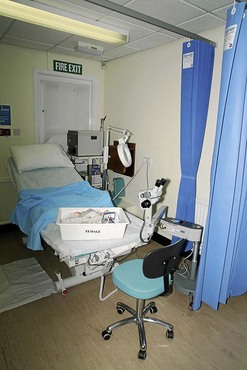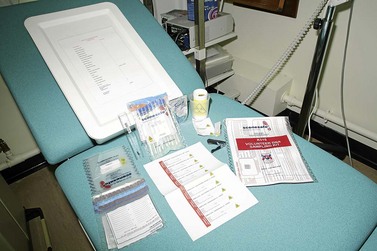CHAPTER 65 Forensic gynaecology
Introduction
There seems to be an escalating epidemic of rape globally, and it is known that the majority of sexual assaults are not reported to the police, and domestic or spousal rape is even less commonly reported. Sexual assault is not only a serious criminal justice problem but is also a major public health issue. In the UK, ‘intimate violence’ is a collective term used for partner abuse, family abuse and sexual assault, with ‘sexual assault’ being defined as indecent exposure, sexual threats and unwanted touching (‘less serious’), rape or assault by penetration including attempts (’serious’) by any person including a partner or family member (Roe 2008). Annual figures relating to crime in England and Wales are published as the Home Office Statistical Bulletin, reflecting not only the police recorded crime but also findings from the British Crime Survey (BCS) (Kershaw et al 2008). The BCS is a large victimization survey of approximately 47,000 adults living in private houses in England and Wales. Based on the 2006/07 BCS self-completion module on intimate violence, approximately 3% of women and 1% of men had experienced a sexual assault (including attempts) in the previous 12 months. The majority of these were less serious sexual assaults. A significant minority (40%) of victims of serious sexual assault had not told anyone about their most recent experience, with only 11% informing the police. A further worrying statistic is that for victims of serious sexual assault, 37% were repeat victims. In a three-city comparative study of client violence against prostitutes working from street and off-street locations, 28% of women involved in street-based prostitution reported attempted rape (Barnard et al 2002).
Most rape allegations do not proceed to court; in 1982–1985, 20% of reported cases went to court in Oslo (Bang 1993). In the UK, the conviction rate for all reported cases is currently between 5.7% and 6.5% (Dyer 2008, Williams 2009). The Home Office figures suggest that actual numbers of convictions for rape are increasing year on year, but the increase in convictions is not keeping pace with the increased reporting, thus there is a high level of attrition or case drop-out. Victims who decline to complete the initial investigative process are more likely to do this in areas where there is no sexual assault referral centre (SARC) (Kelly et al 2005). SARCs are widely regarded as the ideal environment for quality forensic examination, ensuring that the victim has access to other services such as sexual health and professional counsellors.
Legal aspects
The SOA 2003 was a significant overhaul of the UK law that dealt with sexual violence, and there are now new offences such as the offence of rape to include oral and anal penetration with a penis, and assault by penetration; penetration may be by part of the defendant’s body but not the penis, or penetration with an object (Rights of Women 2008).
Medical practitioners need to be aware of the legal context in which they gather evidence, and the forensic examination has a dual purpose: firstly, to address the immediate needs and concerns of women; and secondly, the justice system’s need for the documentation of physical findings, the rigorous collection and preservation of evidence, an interpretation of the findings, and provision of expert opinion in legal proceedings (Kelly and Regan 2003).
Her Majesty’s Government have indicated that they have strengthened the capacity of specialist rape prosecutors and rape coordinators to ensure that the best case is built, and expanded special measures to make it easier for vulnerable victims to give evidence (H.M. Government 2007). Indeed, the Youth Justice and Criminal Evidence Act 1999 legislation gives vulnerable and intimidated witnesses the opportunity to give evidence from behind screens, by video link or for the court to be cleared.
Reasons for failure to report sexual assault
The most important barriers to reporting rape and sexual assault are:
Attrition
Attrition in sexual offences cases refers to cases dropping out from the time of initial complaint to the trial. There is an increasing justice gap for victims as the increasing number of convictions for rape is not keeping pace with the increased reporting (H.M. Crown Prosecution Service Inspectorate 2007). Attrition during investigations begins early. Two significant factors were identified by the review of the handling of investigations by the police and Crown Prosecution Service Inspectorate, one of which is the decision by the victim not to complete the initial process. The other factor was the decision to withdraw support for the investigation or prosecution (H.M. Crown Prosecution Service Inspectorate 2007).
Victim withdrawals occur primarily:
Sexual Assault Referral Centres
In early 2009, there were 24 SARCs in England and Wales, the main client group being complainants of recent sexual assault and where the victim has access to a range of agencies including health, the services of counsellors and trained volunteers (H.M. Crown Prosecution Service Inspectorate 2007). The UK Home Office has indicated that SARCs should have the infrastructure to support ongoing victim care, and there should be adequate training and development and quality assurance. There should also be evidence of operational and management policies and procedures (Home Office 2005). It is important that despite the need for cleanliness in the examination room, there are separate interview rooms with a calming and relaxing feel about them (Kelly and Regan 2003).
The services that SARCs provide include:
The clinical requirements of the SARC include:
Consenting to a medical and forensic examination
In achieving consent for a forensic examination, it is important to remember the principles of confidentiality. The General Medical Council (GMC) indicate that ‘Patients have a right to expect that information about them will be held in confidence by their doctors’, accepting that doctors may have contractual obligations to third parties, such as in their work as police surgeons, and in such circumstances, disclosure may be expected (General Medical Council 2006). In such circumstances, the GMC recommends that the doctor is ‘satisfied that the patient has been told at the earliest opportunity about the purpose of the examination and/or disclosure, the extent of the information to be disclosed and the fact that relevant information cannot be concealed or withheld’.
The complainant may agree to a ‘qualified consent’ (i.e. to the release of information to the prosecution without allowing scrutiny by the defence). If she does not consent to release of the medical details, the examiner may be ordered to disclose information by a judge, in which case the forensic physician (FP) should only disclose information relevant to the request for disclosure. In the ‘Disclosures to courts or in connection with litigation’ section of the GMC document ‘Confidentiality: Protecting and Providing Information’, it is stated ‘You should object to the judge or the presiding officer if attempts are made to compel you to disclose what appear to you to be irrelevant matters’ (General Medical Council 2004). The section continues, ‘You must not disclose personal information to a third party such as a solicitor, police officer or officer of a court without the patient’s express consent’.
Examination of the complainant of sexual assault
The forensic examination may provide vital evidence that identifies the assailant and/or supports the complainant’s account should the case come to court. Not only does the forensic examination itself increase the likelihood of legal action, but having a forensic examination doubles the likelihood of prosecution (McGregor et al 2002, Kelly and Regan 2003).
Who should undertake the examination?
In ideal circumstances, the victim of sexual assault should be allowed to choose the gender of the examining doctor. In the 1980s, the gender of the examining physician was not always felt to be a factor affecting the victim’s response to the medical examination (Hockbaum 1987), but recent evidence shows that most victims (male and female) prefer female staff; 43.5% of victims said that they would not continue the forensic examination if the doctor was male (Chowdhury-Hawkins et al 2008).
Training in sexual assault examination
Few doctors have received formal training in the principles of clinical forensic medicine.
To ensure optimal care for the victims of sexual assault, a coordinated multidisciplinary approach should be made to tackle the theoretical and practical training issues. Local and national programmes have been developed at all levels, from specialist registrars through to continuing medical education of those actively involved in rape examination. Subspecialist gynaecology trainees in sexual and reproductive health are expected to compete the forensic and domestic violence competencies module as part of their subspecialty training, which emphasizes the importance of preserving evidence and maintaining the evidence chain whilst providing appropriate sexual and reproductive health care for the complainants of sexual assault (Royal College of Obstetricians and Gynaecologists 2009).
The examining doctor
The examining doctor must be objective and non-judgemental, and must avoid giving even the smallest cues of suspicion or disbelief which may heighten the victim’s anxiety and emotional trauma, and cause a spiralling decline as her guilt and shame increase and her story is shaken (Dupré et al 1993).
Forensic examination is time-consuming and often lasts in excess of 2 h. A speedy response from the forensic examiner is, however, essential for evidential purposes and victim comfort. The importance of examination within 24 h was emphasized in a study on the outcome of sexual assault victims who pursue legal action (Wiley et al 2003). The characteristics positively associated with a legal outcome included:
The Record of Forensic Examination
Documentation
Complainant and SARC personnel information
Consent
Details of consent to forensic medical examination include:
General medical examination
The Faculty of Forensic and Legal Medicine (FFLM) has reminded forensic examiners about the importance of recording and measuring injuries caused by teeth, and that a full description and overall dimensions should be documented (Rowlinson et al 2008).
Colposcopic examination
Colposcopic examination is known to increase the positive genital findings compared with inspection of the genitalia. A study of 200 cases of sexual assault examined with a colposcope revealed positive findings in 32% on inspection; however, the positive findings increased to 87% with colposcopic examination (Sommers 2006). Where forced digital penetration is alleged, colposcopy has been found to be particularly useful (Rossman et al 2004).
Questions have been raised regarding why photocolposcopic examination of AGI in a sexually assaulted child is considered the ‘gold standard’ of examination, yet gross visualization is the standard procedure in adult examination (Brennan 2006). A possible explanation is that colposcopy is seen as an invasive procedure which is ethically unacceptable.
The significance of some of the genital findings during the colposcopic examination remains controversial, especially when images are interpreted by inexperienced clinicians (Templeton and Williams 2006).





